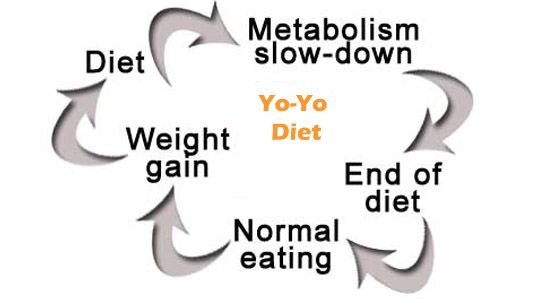Hi all.
Been a while since I did a post. Been really busy at work. So I thought I would talk about the type of diet it sounds like a lot of people here have been on. Namely the Yo-yo diet. I would be interested to know how many people on this forum have lost a ton of weight and then put it all back on again?
But why is this. You have lost a load of weight why would I put it back on? So what is the main cause of this? The answer is I am afraid really simple and might get a few people hot under the collar but here it is. It is because you go on a Diet!!
What, what is he talking about on a diet site, quick hide him and pretend this never happened. Okay let me explain.
Lets start with the word Diet, The word “diet” comes from the Greek root word “diaita”, which means “to live one's life,” Which is a shame because that is exactly what you should be doing. But the word has somehow become linked with losing weight by eating less. The cambridge diet, the 5-2 diet, the Palio diet the juice diet and of course worst of all the slim fast diet. Then we have weight watchers diet and slimming world diets. But what's wrong? lots of people lose weight with these systems. Correct but has anyone done any research to find out how many of these people put all the weight straight back on?
So what the hell is wrong? So lets take a step back. "To Live one's life" Why are you overweight? in simple terms its because the calories you consume in a week are more than the calories you burn. This is a calorie Surplus. There are a few other factors like Macro nutrient breakdown and level of exertion but for the moment lets stick with this. Over a period of time this calorie surplus means your body cannot break down this excess food and it will retain it as Fat (I know this is simplified, but again stick with it). You end up getting bigger. So to lose weight you decide to go on a diet, you work out you BMR add an activity amount, then take off 500 calories and lose a pound of fat a week! Yippee. So what goes wrong. Well simply you do not plan for what you do when you succeed. The problem is as we have already discussed you were eating too many calories and most people think right I have lost that weight and go right back into eating the way they used to eat. So doing the things that made them overweight in the first place. Most diets firms make the calories very small so you have a lot of success, this is not sustainable and (especially with things like the 5-2) when you go back to eating normally, boom it all comes back on with a little extra as the body now reacts by speeding up. So back you go to Weight watchers and they say thanks very much and keep pocketing your money.
So how do we stop the bloody yo-yo. You have to modify your lifestyle. "To Live one's life" The foods you eat in a calorie deficit should be foods you are happy to eat after you finish. Your BMR total plus activity level should mean when you reach your goal eating that calorie amount should keep you at the same weight forever. Don't think fast weight loss, If you have five stone to lose (or 70 lbs) think about food modification for a sustainable healthy lifestyle that will over the course of 75 weeks mean in a year and a half you will get to your goal being healthy. Then when you finish this journey you just carry on eating the same food but just add the 500 calories back. Also remember we are trying to lost Fat, not just weight. Don't just look at the scales or as we call it the "Step of shame", get a good tape measure and measure your waist and your hips this is where we store most our fat so some weeks the scale might not move but the tape will. This is a much better indicator of how you are doing. So lets get on the journey, Remember those who fail to plan, plan to fail.

